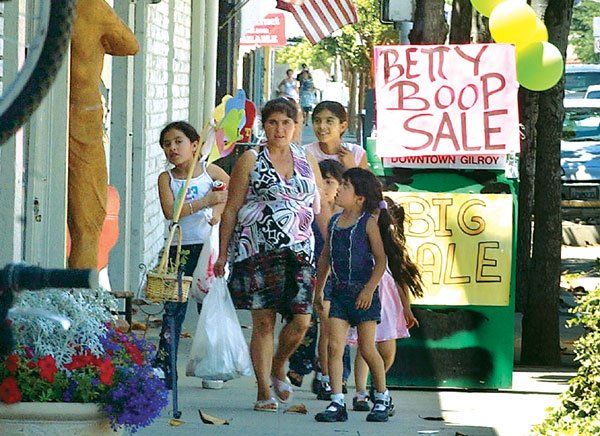Dan Vincent saw the sign.
The A-frame signboard advertising the Gilroy Guitar Gallery,
that is.
The 15-year-old Gilroy High student drove down Fifth Street one
day, noticed the store name emblazoned on the A-frame along with
the word
”
OPEN,
”
and decided to check it out.
Dan Vincent saw the sign.
The A-frame signboard advertising the Gilroy Guitar Gallery, that is.
The 15-year-old Gilroy High student drove down Fifth Street one day, noticed the store name emblazoned on the A-frame along with the word “OPEN,” and decided to check it out.
Kevin Corcoran, owner of the Gilroy Guitar Center, puts out his A-frame signboard every morning.
“It’s a routine,” he said. “It’s like turning on the lights.”
For small businesses like Corcoran’s, such portable signs are a cost-effective way to lure passers-by into the store.
“Unless people are in front of the building and facing us, they won’t be able to see the store,” he said.
As the store is not located on a main street, the Gallery misses out on visibility.
“There’s a lot of foot traffic on Monterey, and (the sign) catches people’s eyes.”
Though Corcoran was not aware of the list of rules governing its use, his sign was of regulation size and material, advertised the allowed information and was correctly placed. He even took the extra step of positioning it so that it would not obstruct doors of parked cars.
That’s one example of how A-frames and the businesses that use them can coexist in harmony with the city’s zoning ordinance.
Other examples around the city, however, have caused some grief.
“It’s an eyesore,” said Mayor Al Pinheiro, referring to A-frames not conforming to regulations. “It’s almost like we’re going to turn into the A-frame capital of the world.”
Such signs may commit a variety of offenses: They can be too close to the curb or too big, they can obstruct pedestrians or the view of drivers, they can be placed illegally on landscape mounds or too far away from the business, amongst other violations.
These portable advertising devices always have been allowed in Gilroy within those limits, but lax regulation has prompted some to sit up and take notice.
“Several people have asked when we’re going to do something about this,” Pinheiro said. “We want to be business-friendly, but it doesn’t make sense to allow this kind of thing.”
Susan Valenta, executive director of the Chamber of Commerce, agrees.
“It makes the place look sloppy,” she said.
Valenta acknowledges small businesses often rely on such signboards to get the word out about their business or a special promotion. She said while some merchants do follow guidelines, “a lot of businesses either aren’t aware or don’t care.”
As the zoning ordinance is lengthy and tedious to read, City Planner Gregg Polubinsky admits confusion also plays a part.
“A lot of the time people just don’t understand (the ordinance),” he said.
Recently, notices of violation were sent to offending businesses near Welburn and Church streets. More will be sent out when staff schedules permit, Polubinsky said.
“It’s a friendly way of telling them about the violation,” he said. “Almost everybody complies.”
Take a stroll down Monterey Street, and it becomes evident that many businesses aren’t in accordance with sign regulations.
One of the them, JJ’s Boops N’ Stuff, has balloons fastened to its board – a no-no in the city’s books.
However, the sign helps to attract customers, and no one has complained.
“The only thing it does is bring in business,” said Amanda Saulino, a friend of the family who helps out at the store. “People always tell us that they saw our balloons.”
Rather than being viewed as “sloppy,” some appreciate the store’s colorful aesthetics.
“I like (the balloons) in fact,” said Jeff Ruster, a Morgan Hill resident in town for business. “My kids would like it.”
However, some compromise must be made or businesses stand to loose the privilege some other cities have banned.
“Unless they take responsibility and follow the guidelines, they will be impacting everyone else,” she cautioned. “If there are too many infractions, the ordinance (permitting portable signs) can be revoked.”
If sending out notices does not work, Pinheiro said he will consider discussing the possibility of fining offending businesses with City Council.
“The only thing right now is the enforcement,” Valenta said. “There’s nothing wrong with A-frame signs themselves.”
Specifications
• Signs should be no bigger than 4 feet tall and 2-and-a-half-feet wide.
• They should be made of a stout material like wood with metal hardware, and all surfaces should be painted. They should be free of attachments that move in the wind.
Content
• Only the name and type of business, special promotions, hours of operation and phone number may be advertised on the sign.
Sign guidelines
Placement
• Signs should be directly in front of the businesses they are advertising and be at least one foot from the curb.
• There should be a pedestrian walkway of at least 4 feet in width.
• Signs should not be placed in any landscape planter, on a sidewalk intersection*, over utility boxes or within 36 inches of a fire hydrant.
• Signs cannot be attached to public property.
• In the downtown commercial district, a portable sign may be placed anywhere on site, as long as it does not block pedestrian paths, driveways, parking stalls or building exits.
• Signs may be displayed only during the hours that the business is open to the public; they need to be taken in at all other times. Signs should not be left out overnight.
*This refers to the corner of sidewalks. A 20-by-20 foot triangle should be left clear for vehicular visibility.














